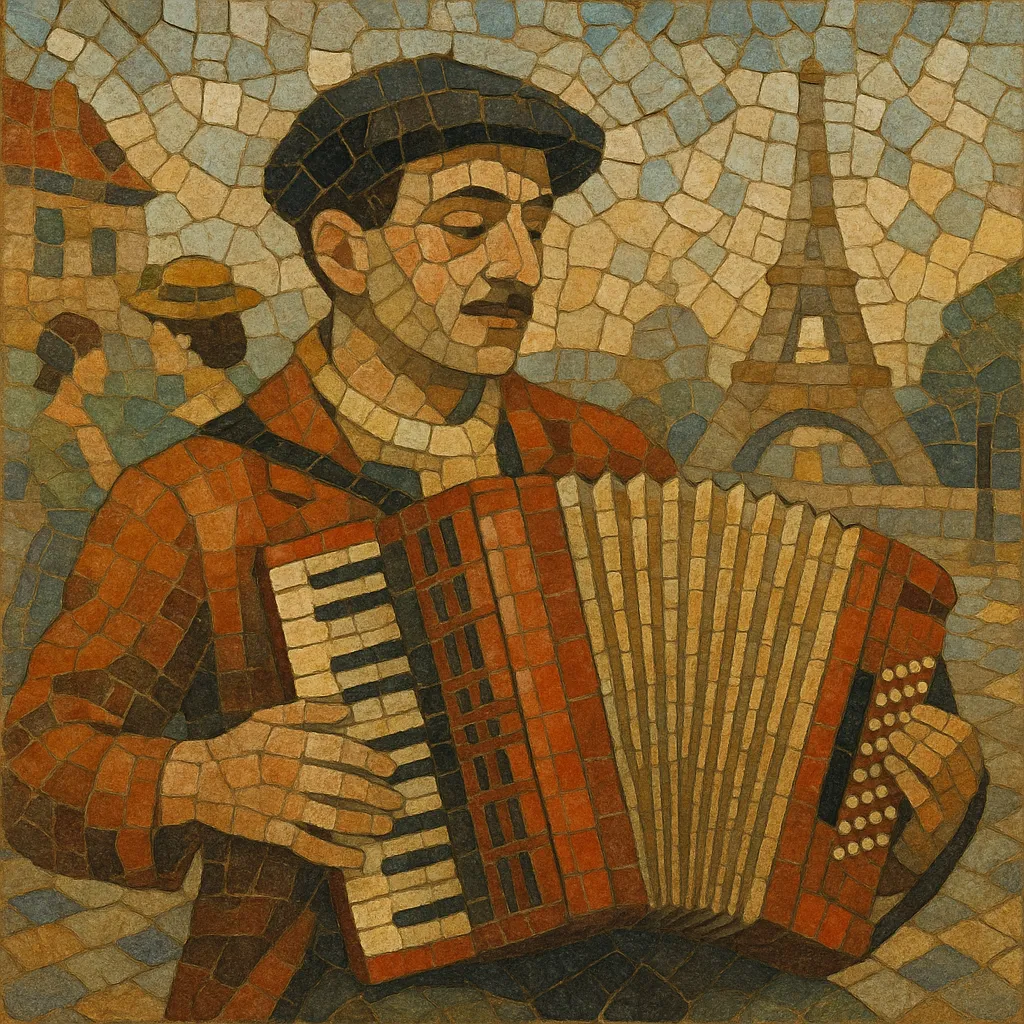Musette is a Paris-born dance and popular music style centered on the accordion and characterized by lilting waltzes, lively polkas, and sentimental melodies. It emerged in the working-class dance halls (bal-musette) of late 19th- and early 20th-century Paris, where Auvergnat bagpipers and Italian accordionists fused rural dance forms with urban nightlife.
Its signature sound comes from tremolo-rich “musette” accordion tuning, which creates a shimmering, slightly detuned chorus effect. The repertoire includes valse-musette (3/4), java, polka, and mazurka, often played at brisk tempos with an infectious, dancing pulse and emotive, nostalgic lyricism.
At once convivial and romantic, musette became a pillar of French popular culture, later intersecting with chanson and jazz (notably via manouche/gypsy jazz), and remains a touchstone for accordion music worldwide.
Musette took shape in Paris’s bal-musette scene in the 1890s, rooted in the dance culture of migrant communities. Auvergnat musicians brought the cabrette (a type of bagpipe once called “musette”), while Italian immigrants popularized the accordion. In crowded dance halls, the powerful, portable accordion gradually displaced the bagpipe, and a new urban dance sound coalesced around waltz, polka, schottische, and mazurka forms.
By the interwar years, the valse-musette became the style’s emblem. Pioneers such as Émile Vacher and the Péguri family standardized ensembles and repertoire, and the characteristic tremolo (“musette”) accordion tuning defined the timbre. Recording and radio spread the genre beyond Paris, while dance variants like the java flourished. In this period, musette intersected with Parisian popular song, helping shape the ambiance of chanson and the café-concert.
From the late 1930s onward, the swing era and Romani/manouche musicians (notably Django Reinhardt’s circle) cross-pollinated with musette. Accordionists like Tony Muréna, Gus Viseur, and Jo Privat absorbed jazz harmonies and improvisation, creating “jazz musette” and an enduring repertoire of waltzes played with manouche guitar “pompe.” After World War II, stars such as Yvette Horner and André Verchuren brought musette to mass audiences, festivals, and television, cementing it as a symbol of French popular culture.
Shifts in youth culture and pop trends reduced musette’s mainstream prominence after the 1960s, yet the style persisted in dance communities and regional fêtes. Periodic revivals, collaborations with chanson and jazz artists, and the continued presence of musette waltzes in gypsy jazz repertoires have kept the tradition alive. Contemporary accordionists and producers revisit musette timbres and melodies, ensuring the genre’s nostalgic, romantic aura remains influential.
Use a piano accordion (or button accordion) with musette tuning: multiple middle reeds slightly detuned (often ±10–25 cents) to produce the characteristic shimmering tremolo. Pair it with rhythm guitar (manouche "pompe" or steady chordal strums), double bass or tuba for bass lines, and light percussion if desired.
Write primarily in 3/4 for valse-musette and java, using an energetic “oom-pah-pah” left-hand pattern on the accordion’s Stradella bass (bass note on beat 1, chords on beats 2–3). For polka and schottische, switch to 2/4 or 4/4 with a bouncy, dance-forward pulse. Keep tempos lively (waltzes often medium-fast), but allow gentle rubato in introductions and cadences for expressivity.
Favor diatonic major keys (G, C, D, A) with frequent secondary dominants and circle-of-fifths motion (e.g., I – VI7 – II7 – V7 – I). Use diminished passing chords and applied dominants to color turnarounds. Brief modulations up a whole or half step add lift between chorus repeats. Endings often feature a rallentando and a cadential flourish.
Compose singable, sentimental melodies with clear phrases (often 8 or 16 bars). Embellish with grace notes, mordents, appoggiaturas, glissandi, bellows shakes, and tasteful vibrato. Balance a lyrical A section with a contrasting B section that explores a nearby key or dominant area before returning to A.
Common forms include A–A–B–A or A–B–A–C with short intros and codas. Start with a pickup phrase, present the main theme, then add a brighter or harmonically spicier section. Arrange for accordion lead with guitar and bass providing steady dance propulsion; consider a manouche-style guitar “pompe” to nod to jazz musette.
Maintain clear, danceable pulse and buoyant articulation. Shape phrases with bellows dynamics, letting cadences breathe. In ensembles, keep accompaniment light so the accordion’s tremolo-rich melody projects, and use brief solos or turnarounds to showcase virtuosity without losing the dancers’ groove.


